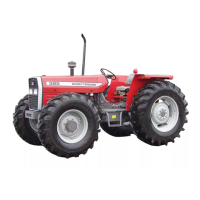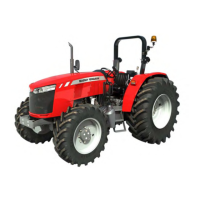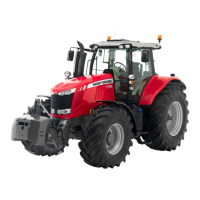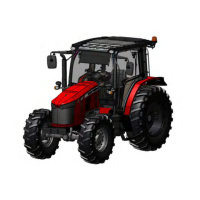Do you have a question about the MASSEY FERGUSON MF 260 and is the answer not in the manual?
Provides a visual overview of maintenance tasks and intervals for various tractor models.
Highlights safety warnings and precautions for operating and maintaining the tractor.
Explains how to read and interpret the tractor's hour meter for usage duration.
Details the locations for identifying tractor serial and engine numbers on different models.
Identifies instruments and control levers specific to MF375, 385, and 385 4WD tractor models.
Identifies instruments and control levers specific to MF240, 350, 260, and 360 tractor models.
Lists essential checks to perform before starting the tractor daily.
Lists essential checks to perform weekly before operating the tractor.
Emphasizes the importance of completing pre-operation checks before starting the engine.
Details grease points on steering column, front wheels, front spindles, and brake pedal bush.
Details grease points on the front axle pivot pin, front axles, and steering pivot pin.
Identifies the grease point on the left linkage of the tractor.
Provides a step-by-step guide on the correct procedure for starting the Massey Ferguson tractor.
Details the correct procedure for safely shutting down the Massey Ferguson tractor.
Provides crucial operating instructions specifically for turbo engines before and after starting/stopping.
Offers advice on optimal engine performance through proper use and maintenance, and avoiding idling.
Explains the importance and procedure for changing the engine oil and oil filter on Massey Ferguson tractors.
Discusses the designated engine temperature range and the role of the thermostat valve.
Provides guidelines on the proper method for running-in a new tractor to ensure longevity.
Explains the fundamental steps for operating the tractor, including starting and moving.
Details how to clean the radiator and oil cooler grills, including recommended pressure and methods.
Explains the procedure for checking the radiator water level safely and when the engine is off.
Highlights the critical function of the radiator cap in maintaining engine temperature and preventing damage.
Provides important advice for operating the tractor in cold climates regarding antifreeze and water.
Explains how to check and adjust the fan-belt tension to prevent engine overheating and alternator damage.
Offers critical tips on using correct belt sizes and avoiding oil/grease during mounting.
Details the importance and daily cleaning procedure for the pre-air cleaner component.
Warns against pouring oil into the pre-air cleaner bowl under any circumstances.
Explains the maintenance of the air-cleaner assembly, including the oil bath and filter element cleaning.
Summarizes daily checks, oil usage, and periodic cleaning for optimal air cleaner performance.
Provides detailed instructions on how to change the primary and secondary diesel filters safely and correctly.
Stresses the importance of regular changes and using genuine filters for the diesel system.
Outlines the method and sequence for changing the engine oil and oil filter, including oil capacity.
Lists common causes that lead to air entering the tractor's fuel system, causing an air-lock.
Provides a detailed step-by-step guide to remove air from the fuel system and restart the engine.
Explains the correct method for filling the diesel tank, emphasizing the use of uncontaminated diesel.
Details the proper method for storing diesel fuel in drums to maintain its quality and prevent contamination.
Explains how to check transmission and hydraulic oil levels, and the importance of regular changes.
Lists the oil capacities for transmission, hydraulic oil, and external hydraulic components for various tractor models.
Introduces the hydrostatic power steering system, its benefits, and key components for MF385/385 4WD tractors.
Advises on using reputable and reliable oil for the power steering system on specified tractor models.
Describes the neutral oil flow in the hydrostatic steering system when the tractor is moving straight.
Explains how the hydrostatic steering system operates when the engine is running and the wheel is turned.
Details the operation of the hydrostatic steering system when the engine is turned off.
Explains how to check and refill steering oil in the mechanical steering system of MF-350/260 models.
Details how to check and refill steering oil in the power steering system of MF-385/375/385 4WD models.
Covers the process of removing old power steering oil and replenishing with new oil, including capacity.
Provides instructions on proper battery care, terminal cleaning, water level checks, and general maintenance.
Details the importance of correct tire air pressure for tractor performance and provides specific pressure values for different models.
Provides a critical instruction on increasing front tire pressure when using heavy front-mounted implements.
Explains the benefits of adding water to tires for improved traction and performance, especially on rear tires.
Details the step-by-step method for filling water into tractor tires using a specialized instrument.
Lists essential precautions, including avoiding freezing temperatures and proper tire removal after filling.
| Engine Type | 4-stroke, direct injection |
|---|---|
| Engine Power | 60 HP |
| Number of Cylinders | 3 |
| Number of Gears | 8 Forward, 2 Reverse |
| PTO Power | 51 HP |
| PTO Speed | 540 RPM |
| Hydraulic System | Open Center |
| Steering | Manual |











